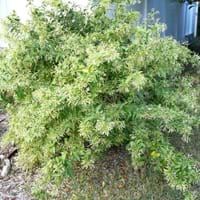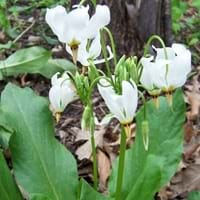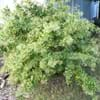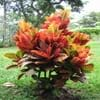Life Span
Perennial
Perennial
Origin
Mexico, Latin America and the Caribbean
Southeastern Asia
Types
Not Available
alpine shootingstar , Jewelled shootingstar , Sierran shootingstar , broad-leaved shootingstar , Frigid Shootingstar
Number of Varieties
Not Available
Habitat
Warm and moist climatic conditions
Floodplains, open Woodlands
USDA Hardiness Zone
9-12
10-15
Sunset Zone
13, 16, 17, 18, 19, 20, 21, 22, 23, 24
H1, H2, 22, 23, 24
Habit
Oval or Rounded
Oval or Rounded
Flower Color
White, Light Green
White, Pink, Salmon, Coral
Flower Color Modifier
Not Available
Bicolor
Fruit Color
Not Available
Non Fruiting Plant
Leaf Color in Spring
Green
Red, Green, Burgundy
Leaf Color in Summer
Green
Gray Green, Dark Green, Burgundy
Leaf Color in Fall
Green
Gray Green, Dark Green, Burgundy
Leaf Color in Winter
Green
Gray Green, Dark Green, Burgundy
Leaf Shape
Ovate
Ovate elongated
Plant Season
Spring, Summer, Fall, Winter
Spring, Winter
Sunlight
Full Sun, Partial Sun
Full Sun, Partial Sun
Type of Soil
Loam, Sand
Loam, Sand
The pH of Soil
Neutral, Alkaline
Acidic, Neutral
Soil Drainage
Well drained
Well drained
Bloom Time
Spring, Late Spring, Early Summer, Summer, Late Summer, Early Fall, Fall
Early Spring, Spring, Late Winter
Tolerances
Drought
Not Available
Where to Plant?
Ground, Pot
Ground, Pot
How to Plant?
Stem Cutting, Transplanting
Seedlings
Plant Maintenance
Medium
Medium
Watering Requirements
Requires regular watering
Average Water Needs
In Summer
Lots of watering
Lots of watering
In Spring
Moderate
Moderate
In Winter
Average Water
Average Water
Soil pH
Neutral, Alkaline
Acidic, Neutral
Soil Type
Loam, Sand
Loam, Sand
Soil Drainage Capacity
Well drained
Well drained
Sun Exposure
Full Sun, Partial Sun
Full Sun, Partial Sun
Pruning
Prune in the growing season, Prune to half of its height, Remove dead branches
Prune after flowering, Remove damaged leaves, Remove dead branches, Remove dead leaves
Fertilizers
fertilize every 2-3 weeks while growing, light feeding and water solubles
All-Purpose Liquid Fertilizer
Pests and Diseases
Aphids, Black spots, Caterpillars, Foliar disease, Sap-Sucking Insects, White spots
Aphids, Fungal leaf spots
Plant Tolerance
Drought
Drought
Flower Petal Number
Single
Single
Showy Fruit
Yes
Not Available
Foliage Texture
Medium
Coarse
Foliage Sheen
Glossy
Matte
Invasive
Sometimes
Sometimes
Attracts
Hummingbirds
Hummingbirds, Butterflies
Allergy
Asthma, Respiratory problems
Runny nose, sneezing
Aesthetic Uses
Cottage Garden, Showy Purposes
along a porch, deck or patio, Beautification, Mixed Border, small hedge
Beauty Benefits
Not Available
Not Available
Environmental Uses
Air purification
Air purification
Medicinal Uses
Analgesic, Antidepressant, Antiseptic, Antispasmodic, Aphrodisiac, Conjuctivitis, Fever, Immunity, Urine infections, Used as a sedative
Unknown
Part of Plant Used
Flowers
Not Available
Other Uses
Oil is used in perfume, soaps, creams, etc.
Unknown
Used As Indoor Plant
No
No
Used As Outdoor Plant
Yes
Yes
Garden Design
Container, Feature Plant, Foundation, Hedges, Mixed Border, Screening, Wind Break, Topiary, Bonsai, Espalier, Tropical
Container, Feature Plant, Foundation, Hedges, Mixed Border, Screening, Wind Break, Tropical
Botanical Name
CESTRUM nocturnum
CLERODENDRUM quadriloculare
Common Name
night-blooming jasmine, night-blooming cestrum, lady of the night, queen of the night, night-blooming jessamine
American cowslip , mosquito bills , mad violets , sailor caps
In Hindi
रातरानी
shooting star
In German
Nachtjasmin
shooting star
In French
jasmin de nuit
Dodecatheon
In Spanish
dama de noche
Dodecatheon
In Greek
νύχτα γιασεμιά
shooting star
In Portuguese
jasmim-da-noite
Dodecatheon
In Polish
noc kwitnący jaśmin
shooting star
In Latin
nox Aenean virent
shooting star
Phylum
Magnoliophyta
Spermatophyta
Class
Magnoliopsida
Magnoliopsida
Order
Solanales
Primulales
Family
Solanaceae
Verbenaceae
Genus
Cestrum
Dodecatheon
Clade
Angiosperms, Asterids, Eudicots
Angiosperms, Asterids, Eudicots
Tribe
Not Available
Not Available
Subfamily
Not Available
Not Available
Number of Species
Not Available
Season and Care of Night Blooming Jasmine and Shooting Star
Season and care of Night Blooming Jasmine and Shooting Star is important to know. While considering everything about Night Blooming Jasmine and Shooting Star Care, growing season is an essential factor. Night Blooming Jasmine season is Spring, Summer, Fall and Winter and Shooting Star season is Spring, Summer, Fall and Winter. The type of soil for Night Blooming Jasmine is Loam, Sand and for Shooting Star is Loam, Sand while the PH of soil for Night Blooming Jasmine is Neutral, Alkaline and for Shooting Star is Acidic, Neutral.
Night Blooming Jasmine and Shooting Star Physical Information
Night Blooming Jasmine and Shooting Star physical information is very important for comparison. Night Blooming Jasmine height is 120.00 cm and width 180.00 cm whereas Shooting Star height is 240.00 cm and width 180.00 cm. The color specification of Night Blooming Jasmine and Shooting Star are as follows:
Night Blooming Jasmine flower color: White and Light Green
Night Blooming Jasmine leaf color: Green
Shooting Star flower color: White, Pink, Salmon and Coral
- Shooting Star leaf color: Red, Green and Burgundy
Care of Night Blooming Jasmine and Shooting Star
Care of Night Blooming Jasmine and Shooting Star include pruning, fertilizers, watering etc. Night Blooming Jasmine pruning is done Prune in the growing season, Prune to half of its height and Remove dead branches and Shooting Star pruning is done Prune after flowering, Remove damaged leaves, Remove dead branches and Remove dead leaves. In summer Night Blooming Jasmine needs Lots of watering and in winter, it needs Average Water. Whereas, in summer Shooting Star needs Lots of watering and in winter, it needs Average Water.





